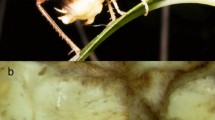Abstract
In Rhizoglyphus echinopus (Fumouze and Robin) two male morphs occur: heteromorphs, with a thickened and sharply terminated third pair of legs that serve as a weapon in intrasexual conflicts, and homeomorphs, with unmodified legs. This study investigated the system of male morph determination. No significant heritability of male morph was found, but cues emanating from a dense colony were found to suppress the production of heteromorphs. Developmental plasticity was retained throughout the protonymphal stage. Diet did not influence morph expression, but lowered temperature decreased the proportion of heteromorphs emerging.
Similar content being viewed by others
References
Bradshaw, A.D. 1973. Homeostasis and polymorphism in vernal development of Chaoborus americanus. Ecology 54: 1247-1259.
Diaz, A.,Okabe, K.,Eckenrode, C.J.,Villani, M.G. andOConnor, B.M. 2000. Biology, ecology, and management of the bulb mites of the genus Rhizoglyphus (Acari: Acaridae). Exp. Appl. Acarol. 24: 85-113.
Foa, A. 1919. Studio del polimorfismo unisessuale del Rhizolyphus echinopus. Memoria Accad. Pontificia Nuovi Lincei. Roma Ser. V 12: 3-109.
Gerson, U.,Capua, S. andThorens, D. 1983. Life history and life tables of Rhizoglyphus robini Claparede (Acari: Astigmata: Acaridae). Acarologia 24: 439-448.
Gross, M.R. 1996. Alternative reproductive strategies and tactics: diversity within sexes. Trends Ecol. Evol. 11: 92-98.
Hughes, A.M. 1976. The mites of stored food and houses. Tech. Bull. 9, Minis. Agric. Fish. Food, London.
Manson, D.C.M. 1972. A contribution to the study of the genus Rhizoglyphus Claparede, 1969 (Acarina: Acaridae). Acarologia 13: 621-650.
Moran, N.A. 1992. The evolutionary maintenance of alternative phenotypes. Am. Nat. 139: 971-989.
Oliver, J.H. Jr 1977. Cytogenetics of mites and ticks. Ann. Rev. Entomol. 22: 407-429.
Radwan, J. 1993a. The adaptive significance of male polymorphism in the acarid mite Caloglyphus berlesei. Behav. Ecol. Sociobiol. 33: 201-208.
Radwan, J. 1993b. Kin recognition in the acarid mite, Caloglyphus berlesei-negative evidence. Anim. Behav. 45: 200-202.
Radwan, J. 1995. Male morph determination in two species of acarid mites. Heredity 74: 669-673.
Radwan, J. andBogacz, I. 2000. Comparison of life-history traits of the two male morphs of the bulb mite, Rhizoglyphus robini. Exp. Appl. Acarol. 24: 115-121.
Radwan, J.,Czyz M.,Konior, M. andKolodziejczyk, M., 2000. Aggressiveness in the two male morphs of the bulb mite, Rhizoglyphus robini. Ethology 106: 53-62.
Radwan, J. andKlimas, M. 2001. Male dimorphism in the bulb mite: fighters survive better. Ethol. Ecol. Evol. 13: 69-79.
Roff, D.A. 1996. The evolution of threshold traits in animals. The Quart. Rev. Biol. 71: 1-35.
Timms, S.,Ferro, D.N. andEmberson, R.M. 1980a. Selective advantage of pleomorphic male Sancassania berlesei (Michael) (Acari: Acaridae). Int. J. Acarol. 6: 97-102.
Timms, S.,Ferro, D.N. andWaller, J.B. 1980b. Suppression of production of pleomorphic males in Sancassania berlesei (Michael) (Acari: Acaridae). Int. J. Acarol. 6: 91-96.
Timms, S.,Ferro, D.N. andEmberson, R.M. 1981. Andropolymorphism and its heritability in Sancassnia berlesei (Michael) (Acari: Acaridae). Acarologia 22: 391-398.
Wcislo, W.T. 1989. Behavioral environments and evolutionary change. Annu. Rev. Ecol. Syst. 20: 137-169.
Woodring, J.P. 1969a. Environmental regulation of andropolymorphism in Tyroglyphids (Acari). In: Proceedings of the 2nd International Congress of Acarology, G.O. Evans (ed.), pp. 433-440. Academiai Kiado, Budapest.
Woodring, J.P. 1969b. Observations on the biology of six species of acarid mites. Ann. Entomol. Soc. Am. 62: 102-108.
Author information
Authors and Affiliations
Rights and permissions
About this article
Cite this article
Radwan, J. Male Morph Determination in Rhizoglyphus Echinopus (Acaridae). Exp Appl Acarol 25, 143–149 (2001). https://doi.org/10.1023/A:1010688516704
Issue Date:
DOI: https://doi.org/10.1023/A:1010688516704




